Heat and Cold-Stressed Individuals of Pistacia lentiscus (Mastic Tree) Do Modify Their Secreting Profile
Abstract
1. Introduction
2. Results
2.1. Microscopy—Leaf Anatomy
2.2. Biomass, Reactive Oxygen Species (ROS), and Pigments
2.3. DDC Expression
3. Discussion
4. Material and Methods
4.1. Plant Material, Experimental Set-Up and Culture Conditions
4.2. Plant Anatomy and Microscopy
4.3. Photosynthetic Pigments Protocol
4.4. DDC Expression and Quantification
4.5. Total Reactive Oxygen Species (ROS) Estimation
4.6. Statistical Analysis
4.7. Selection of Biogenic Amines/Amino Acids for UPLC-Triple TOF MS Quantitation
4.8. Method Development and Assessment—Quantitation of Biogenic Amines/Amino Acids in Pistacia Lentiscus Leaves via UPLC-TripleTOF MS
4.9. Extraction and Sample Preparation for the Analytical Part
4.10. Quantitative Analysis of Biogenic Amines and Amino Acids via UPLC-TripleTOF MS
4.11. Statistical Analysis of Quantitation Results
5. Conclusions
Supplementary Materials
Author Contributions
Funding
Data Availability Statement
Acknowledgments
Conflicts of Interest
References
- Kummerow, J. Comparative Anatomy of Sclerophylls of Mediterranean Climatic Areas. In Mediterranean Type Ecosystems. Origin and Structure, Ecological Studies No 7; di Castri, F., Mooney, H.A., Eds.; Springer: Berlin, Germany, 1973; pp. 157–167. [Google Scholar]
- Mooney, H.A.; Dunn, E.L. Convergent evolution of the mediterranean climate evergreen sclerophyll shrubs. Evolution 1970, 24, 292–303. [Google Scholar] [CrossRef]
- Parsons, D.J. Chaparral. Pac. Discov. 1976, 29, 21–27. [Google Scholar]
- Margaris, N.S. Adaptive Strategies in Plants Dominating Mediterranean-Type Ecosystems. In Mediterranean-Type Shrublands; Di Castri, F., Goodall, D.W., Specht, R., Eds.; Elsevier: Amsterdam, The Netherlands, 1981; pp. 239–242. [Google Scholar]
- Mitrakos, K.; Christodoulakis, N.S. Leaf Structural Diversity in Mediterranean Evergreen Sclerophylls. In Components of Productivity of Mediterranean-Climate Regions-Basic and Applied Aspects; Margaris, N.S., Mooney, H.A., Eds.; Dr W. Junk Publishers: The Hague, The Netherlands; Boston, MA, USA; London, UK, 1981; pp. 21–25. [Google Scholar]
- Christodoulakis, N.S.; Mitrakos, K. Structural Analysis of Sclerophylly in Eleven Evergreen Phanerophytes in Greece. In Plant Response to Stress; ASI Series; Tenhunen, J.D., Catarino, E.M., Lange, O.L., Oechel, W.C., Eds.; Springer: Berlin/Heidelberg, Germany, 1987; Volume 15, pp. 547–551. [Google Scholar]
- Fahn, A. Secretory tissues in vascular plants. New Phytol. 1988, 108, 229–257. [Google Scholar] [CrossRef] [PubMed]
- Christodoulakis, N.S. Structural Diversity and Adaptations in Some Mediterranean Evergreen Sclerophyllous Species. Environ. Exp. Bot. 1992, 32, 295–305. [Google Scholar] [CrossRef]
- Christodoulakis, N.S.; Tsimbani, H.; Fasseas, C. Leaf Structural Peculiarities in Sarcopoterium spinosum, a Seasonally Dimorphic Subshrub. Ann. Bot. 1990, 65, 291–300. [Google Scholar] [CrossRef]
- Christodoulakis, N.S.; Fasseas, C. Seasonal Dimorphism of Phlomis fruticosa under Controlled Environmental conditions. Acta Oecol. 1991, 12, 323–330. [Google Scholar]
- Christodoulakis, N.S.; Georgoudi, M.; Fasseas, C. Leaf structure of Cistus creticus L. (rock rose), a medicinal plant widely used in folk remedies since ancient times. J. Herbs Spices Med. Plants 2014, 20, 103–114. [Google Scholar] [CrossRef]
- Stefi, A.L.; Vassilacopoulou, D.; Margaritis, L.H.; Christodoulakis, N.S. Oxidative stress and an animal neurotransmitter synthesizing enzyme in the leaves of wild growing myrtle after exposure to GSM radiation. Flora 2018, 243, 67–76. [Google Scholar] [CrossRef]
- Balandrin, M.F.; Klocke, J.A.; Wurtele, E.S.; Bollinger, W.H. Natural plant chemicals: Sources of industrial and medicinal materials. Science 1985, 228, 1154–1160. [Google Scholar] [CrossRef] [PubMed]
- Wijesekera, R.O.B. Plant-Derived Medicines and Their Role in Global Health. In The Medicinal Plant Industry; Wijesekera, R.O.B., Ed.; CRC Press: Boca Raton, FL, USA, 1991; pp. 1–18. [Google Scholar]
- Ascensão, L.; Mota, L.; De Castro, M. Glandular trichomes on the leaves and flowers of Plectranthus ornatus: Morphology, distribution and cytochemistry. Ann. Bot. 1999, 84, 437–447. [Google Scholar] [CrossRef]
- Corsi, G.; Bottega, S. Glandular hairs of Salvia officinalis: New data on morphology, localization and histochemistry in relation to function. Ann. Bot. 1999, 84, 657–664. [Google Scholar] [CrossRef]
- Sacchetti, G.; Romagnoli, C.; Nicoletti, M.; Di Fabio, A.; Bruni, A.; Poli, F. Glandular trichomes of Calceolaria adscendens Lidl. (Scrophulariaceae): Histochemistry, development and ultrastructure. Ann. Bot. 1999, 83, 87–92. [Google Scholar] [CrossRef]
- McChesney, J.D.; Venkataraman, S.K.; Henri, J.T. Plant natural products: Back to the future or into extinction? Phytochemistry 2007, 68, 2015–2022. [Google Scholar] [CrossRef] [PubMed]
- Stefi, A.L.; Vassilacopoulou, D.; Christodoulakis, N.S. Environmentally stressed summer leaves of the seasonally dimorphic Phlomis fruticosa and the relief through the L-Dopa decarboxylase (DDC). Flora 2019, 251, 11–19. [Google Scholar] [CrossRef]
- Stefi, A.L.; Mitsigiorgi, K.; Vassilacopoulou, D.; Christodoulakis, N.S. Response of young Nerium oleander plants to long-term non-ionizing radiation. Planta 2020, 251, 108–125. [Google Scholar] [CrossRef] [PubMed]
- Stefi, A.L.; Vassilacopoulou, D.; Routsi, E.; Stathopoulos, P.; Argyropoulou, A.; Skaltsounis, A.-L.; Christodoulakis, N.S. The Combined Environmental Stress on the Leaves of Olea europaea L. and the Relief Mechanism Through Biosynthesis of Certain Secondary Metabolites. J. Plant Growth Regul. 2020, 40, 1044–1059. [Google Scholar] [CrossRef]
- Tocher, R.D.; Tocher, C.S. Dopa decarboxylase in Cytisus scoparius. Phytochemistry 1972, 11, 1661–1667. [Google Scholar] [CrossRef]
- Iriti, M. Plant neurobiology, a fascinating perspective in the field of research on plant secondary metabolites. Int. J. Mol. Sci. 2013, 14, 10819–10821. [Google Scholar] [CrossRef] [PubMed]
- Jaffe, M.J. Evidence for the regulation of phytochrome-mediated processes in bean roots by the neurohumor, acetylcholine. Plant Physiol. 1970, 46, 768–777. [Google Scholar] [CrossRef] [PubMed]
- Barlow, R.B.; Dixon, R.O.D. Choline acetyltransferase in the nettle Urtica dioica L. Biochem. J. 1973, 132, 15–18. [Google Scholar] [CrossRef] [PubMed]
- Odjakova, M.; Hadjiivanova, C. Animal neurotransmitter substances in plants. Bulg. J. Plant Physiol. 1997, 23, 94–102. [Google Scholar]
- Soares, A.R.; Marchiosi, R.; Siqueira-Soares, R.D.C.; Barbosa de Lima, R.; Dantas dos Santos, W.; Ferrarese-Filho, O. The role of L-DOPA in plants. Plant Signal. Behav. 2014, 9, e28275. [Google Scholar] [CrossRef] [PubMed]
- Kulma, A.; Szopa, J. Catecholamines are active compounds in plants. Plant Sci. 2007, 172, 433–440. [Google Scholar] [CrossRef]
- Dioscorides, (77 AC). De Materia Medica; Militos Publications: Athens, Greece, 2001; ISBN 960-8033-01-02. [Google Scholar]
- Pachi, V.K.; Mikropoulou, E.V.; Dimou, S.; Dionysopoulou, M.; Argyropoulou, A.; Diallinas, G.; Halabalaki, M. Chemical profiling of Pistacia lentiscus var Chia resin and essential oil: Ageing markers and antimicrobial activity. Processes 2021, 9, 418. [Google Scholar]
- Stefi, A.L.; Nikou, T.; Vassilacopoulou, D.; Skaltsounis, A.L.; Halabalaki, M.; Christodoulakis, N.S. Structure and organization of the secretion apparatus of the mastic tree (Pistacia lentiscus L.) and LC–HRMS analysis of leaf extracts. Planta 2021, 253, 70. [Google Scholar] [CrossRef] [PubMed]
- Magiatis, P.; Melliou, E.; Skaltsounis, A.L.; Chinou, I.; Mitaku, S. Chemical composition and antimicrobial activity of the essential oils of Pistacia lentiscus var. chia. Planta Med. 1999, 65, 749–752. [Google Scholar] [CrossRef] [PubMed]
- Koutsoudaki, C.; Krsek, M.; Rodger, A. Chemical composition and antibacterial activity of the essential oil and the gum of Pistacia lentiscus var. chia. J. Agric. Food Chem. 2005, 53, 7681–7685. [Google Scholar] [CrossRef]
- Andrikopoulos, N.K.; Kaliora, A.C.; Assimopoulou, A.N.; Papageorgiou, V.P. Biological activity of some naturally occurring resins, gums and pigments against in vitro LDL oxidation. Phytother. Res. 2003, 17, 501–507. [Google Scholar] [CrossRef] [PubMed]
- Huwez, F.U.; Thirlwell, D.; Cockayne, A.; Ala’Aldeen, D.A. Mastic gum kills Helicobacter pylori. N. Eng. J. Med. 1998, 339, 1946. [Google Scholar] [CrossRef] [PubMed]
- Marone, P.; Bono, L.; Leone, E.; Bona, S.; Carretto, E.; Perversi, L. Bactericidal activity of Pistacia lentiscus mastic gum against Helicobacter pylori. J. Chemother. 2001, 13, 611–614. [Google Scholar] [CrossRef] [PubMed]
- Sawidis, T.; Yurukova, L.; Askitis, T. Chios mastic, a natural supplement for zinc to enhance male sexuality and prostate function. Pharm. Biol. 2010, 48, 48–54. [Google Scholar] [CrossRef] [PubMed][Green Version]
- Balan, K.V.; Demetzos, C.; Prince, J.; Dimas, K.; Cladaras, M. Induction of apoptosis in human colon cancer HCT116 cells treated with an extract of the plant product, Chios mastic gum. Vivo 2005, 19, 93–102. [Google Scholar]
- Loutrari, H.; Magkouta, S.; Pyriochou, A.; Koika, V.; Kolisis, F.N.; Papapetropoulos, A.; Roussos, C. Mastic oil from Pistacia lentiscus var chia inhibits growth and survival of human K562 leukemia cells and attenuates angiogenesis. Nutr. Cancer 2006, 55, 86–93. [Google Scholar]
- Aronne, G.; De Micco, V. Seasonal dimorphism in the Mediterranean Cistus incanus L. subsp. incanus. Ann. Bot. 2001, 87, 789–794. [Google Scholar] [CrossRef]
- Larcher, W. Temperature stress and survival ability of Mediterranean schlerophyllous plants. Plant Bios. 2000, 134, 279–295. [Google Scholar] [CrossRef]
- Faria, T.; Silvério, D.; Breia, E.; Cabral, R.; Abadía, A.; Abadía, J.; Pereira, J.S.; Chaves, M.M. Differences in the response of carbon assimilation to summer stress (water deficits, high light and temperature) in four Mediterranean tree species. Physiol. Plant 1998, 102, 419–428. [Google Scholar] [CrossRef]
- Mitrakos, K.; Diamantoglou, S.; Christodoulakis, N.S. Distribution Patterns of four mediterranean evergreen sclerophyllous species in Greece. Bot. Jahrb. Syst. 1991, 113, 1–6. [Google Scholar]
- Hasanuzzaman, M.; Nahar, K.; Fujita, M. Extreme Temperature Responses, Oxidative Stress and Antioxidant Defense in Plants. In Abiotic Stress Plant Responses and Applications in Agriculture; Vahdati, K., Charles Leslie, C., Eds.; IntechOpen: London, UK, 2013. [Google Scholar] [CrossRef]
- Jung, S.; Kim, J.S.; Cho, K.Y.; Tae, G.S.; Kang, B.G. Antioxidant responses of cucumber (Cucumis sativus) to photoinhibition and oxidative stress induced by norflurazon under high and low PPFDs. Plant Sci. 2000, 153, 145–154. [Google Scholar] [CrossRef]
- Mittler, R. Oxidative stress, antioxidants and stress tolerance. Trends Plant Sci. 2002, 7, 405–410. [Google Scholar] [CrossRef] [PubMed]
- Ahanger, M.A.; Gul, F.; Ahmad, P.; Akram, N.A. Environmental Stresses and Metabolomics—Deciphering the Role of Stress Responsive Metabolites. In Plant Metabolites and Regulation Under Environmental Stress; Elsevier BV: Amsterdam, The Netherlands, 2018; pp. 53–67. [Google Scholar]
- Nikiforou, C.; Manetas, Y. Strength of winter leaf redness as an indicator of stress vulnerable individuals in Pistacia lentiscus. Flora 2010, 205, 424–427. [Google Scholar] [CrossRef]
- Intergovernmental Panel on Climate Change (IPCC). Fourth Assessment Report. In Climate Change 2007; Synthesis Report; World Meteorological Organization: Geneva, Switzerland, 2007. [Google Scholar]
- Nagarajan, S.; Jagadish, S.V.K.; Prasad, A.H.; Thomar, A.; Anand, A.; Pal, M.; Agarwal, P. Local climate affects growth, yield and grain quality of aromatic and non-aromatic rice in northwestern India. Agric. Ecosyst. Environ. 2010, 138, 274–281. [Google Scholar] [CrossRef]
- Scafaro, A.P.; Haynes, P.A.; Atwell, B.J. Physiological and molecular changes in Oryza meridionalis Ng., a heat-tolerant species of wild rice. J. Exp. Bot. 2010, 61, 191–202. [Google Scholar] [CrossRef] [PubMed]
- Xu, S.; Li, J.; Zhang, X.; Wei, H.; Cui, L. Effects of heat acclimation pretreatment on changes of membrane lipid peroxidation, antioxidant metabolites, and ultrastructure of chloroplasts in two cool-season turfgrass species under heat stress. Environ. Exp. Bot. 2006, 56, 274–285. [Google Scholar] [CrossRef]
- Foyer, C.H.; Noctor, G. Redox Regulation in Photosynthetic Organisms: Signaling, Acclimation, and Practical Implications. Antioxid. Redox Signal. 2009, 11, 861–905. [Google Scholar] [CrossRef] [PubMed]
- Stefi, A.L.; Margaritis, L.H.; Christodoulakis, N.S. The effect of the non-ionizing radiation on exposed, laboratory cultivated maize (Zea mays L.) plants. Flora 2017, 233, 22–30. [Google Scholar] [CrossRef]
- Stefi, A.L.; Margaritis, L.H.; Christodoulakis, N.S. The aftermath of long-term exposure to non-ionizing radiation on laboratory cultivated pine plants (Pinus halepensis M.). Flora 2017, 234, 173–186. [Google Scholar] [CrossRef]
- Kaur, H.; Mukherjee, S.; Baluska, F.; Bhatla, S.C. Regulatory roles of serotonin and melatonin in abiotic stress tolerance in plants. Plant Signal. Behav. 2015, 10, e1049788. [Google Scholar] [CrossRef] [PubMed]
- Kang, K.; Kim, Y.S.; Park, S.; Back, K. Senescence-induced serotonin biosynthesis and its role in delaying senescence in rice leaves. Plant Physiol. 2009, 150, 1380–1393. [Google Scholar] [CrossRef] [PubMed]
- Pavli, O.I.; Vlachos, C.E.; Kalloniati, C.; Flemetakis, E.; Skaracis, G.N. Metabolite profiling reveals the effect of drought on sorghum (Sorghum bicolor L. Moench) metabolism. Plant Omics. J. 2013, 6, 371–376. [Google Scholar]
- Schenck, C.A.; Maeda, H.A. Tyrosine biosynthesis, metabolism, and catabolism in plants. Phytochemistry 2018, 149, e102. [Google Scholar] [CrossRef] [PubMed]
- Wang, J.; Yuan, B.; Xu, Y.; Huang, B. Differential responses of amino acids and soluble proteins to heat stress associated with genetic variations in heat tolerance for hard fescue. J. Am. Soc. Hortic. Sci. 2018, 143, 45–55. [Google Scholar] [CrossRef]
- Arnao, M.B.; Hernández-Ruiz, J. Growth conditions influence the melatonin content of tomato plants. Food Chem. 2013, 138, 1212–1214. [Google Scholar] [CrossRef]
- Raza, A.; Su, W.; Hussain, M.A.; Mehmood, S.S.; Zhang, X.; Cheng, Y.; Zou, X.; Lv, Y. Integrated Analysis of Metabolome and Transcriptome Reveals Insights for Cold Tolerance in Rapeseed (Brassica napus L.). Front. Plant Sci. 2021, 12, 721681. [Google Scholar] [CrossRef] [PubMed]
- Vogt, T. Phenylpropanoid biosynthesis. Mol. Plant 2010, 3, 2–20. [Google Scholar] [CrossRef] [PubMed]
- Bors, W.; Heller, W.; Michel, C.; Saran, M. Flavonoids as antioxidants: Determination of radical-scavenging efficiencies. Methods Enzymol. 1990, 186, 343–355. [Google Scholar]
- Kanazawa, K.; Sakakibara, H. High content of dopamine, a strong antioxidant, in Cavendish banana. J. Agric. Food Chem. 2000, 48, 844–848. [Google Scholar] [CrossRef] [PubMed]
- Juárez-Olguín, H.; Calderón-Guzmán, D.; Hernández-García, E.; Barragán-Mejía, G. The Role of Dopamine and Its Dysfunction as a Consequence of Oxidative Stress. In Oxidative Medicine and Cellular Longevity; Bulteau, A.L., Ed.; Hindawi Publishing Corporation: London, UK, 2016; p. 9730467. [Google Scholar]
- Liu, Q.; Gao, T.; Liu, W.; Liu, Y.; Zhao, Y.; Liu, Y.; Li, W.; Ding, K.; Ma, F.; Li, C. Functions of dopamine in plants: A review. Plant Signal. Behav. 2020, 15, 1827782. [Google Scholar] [CrossRef]
- Świędrych, A.; Lorenc-Kukuła, K.; Skirycz, A.; Szopa, J. The catecholamine biosynthesis route in potato is affected by stress. Plant Physiol. Biochem. 2004, 42, 593–600. [Google Scholar] [CrossRef] [PubMed]
- Van den Berg, A.E.; Koole, S.L.; Van der Wulp, N.Y. Environmental preference and restoration: (How) are they related? J. Environ. Psychol. 2003, 23, 135–146. [Google Scholar] [CrossRef]
- Eldadah, M.K.; Schwartz, P.H.; Harrison, R.; Newth, C.J. Pharmacokinetics of dopamine in infants and children. Crit. Care Med. 1991, 19, 1008–1011. [Google Scholar] [CrossRef]
- Benoit-Marand, M.; Jaber, M.; Gonon, F. Release and elimination of dopamine in vivo in mice lacking the dopamine transporter: Functional consequences. Eur. J. Neurosci. 2000, 12, 2985–2992. [Google Scholar] [CrossRef] [PubMed]
- Tsakaldimi, M.; Ganatsas, P. Treatments improving seeds germination of two mediterranean sclerophyll species Ceratonia siliqua and Pistacia lentiscus. In Proceedings of the Third Balkan Scientific Conference on Study, Conservation and Utilization of Forest Resources, Sofia, Bulgaria, 2–6 October 2001; Volume 2, pp. 119–127. [Google Scholar]
- Gordon, A.G.; Rowe, D.C.F. Seed Manual for Ornamental Trees and Shrubs. Bulletin—Forestry Commission (UK), No. 59; Her Majesty’s Stationery Office-Crown Copyright: London, UK, 1982. [Google Scholar]
- Christodoulakis, N.S.; Kogia, D.; Mavroeidi, D.; Fasseas, C. Anatomical and cytochemical investigation on the leaf of Teucrium polium L.: A pharmaceutical shrub of the Greek phryganic formations. J. Biol. Res. 2010, 14, 199–209. [Google Scholar]
- Gechev, T.; Mehterov, N.; Denev, I.; Hille, J. A Simple and Powerful Approach for Isolation of Arabidopsis Mutants with Increased Tolerance to H2O2. In Induced Cell Death Methods in Enzymology; Cadenas, E., Packer, L., Eds.; Elsevier: Amsterdam, The Netherlands, 2013; Volume 527, ISSN 0076-6879. [Google Scholar]
- Erdag, D.; Merhan, O.; Yildiz, B. Biochemical and Pharmacological Properties of Biogenic Amines. In Biogenic Amines; Proestos, C., Ed.; IntechOpen: London, UK, 2018. [Google Scholar] [CrossRef]
- Özogul, Y.; Özogul, F. Chapter 1—Biogenic Amines Formation, Toxicity, Regulations in Food. In Biogenic Amines in Food: Analysis, Occurrence and Toxicity; Saad, B., Tofalo, R., Eds.; The Royal Society of Chemistry: London, UK, 2020; pp. 1–17. [Google Scholar]
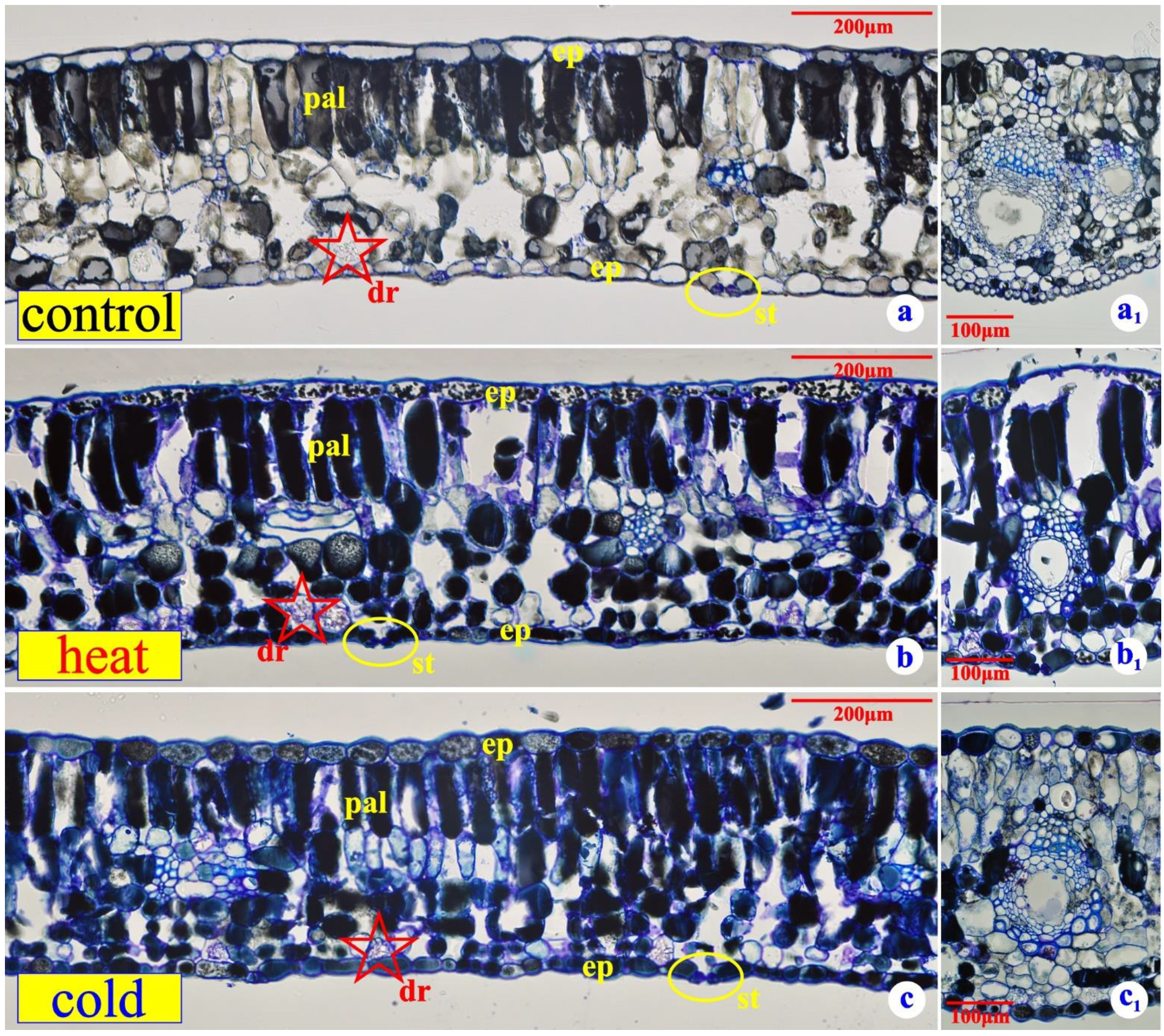
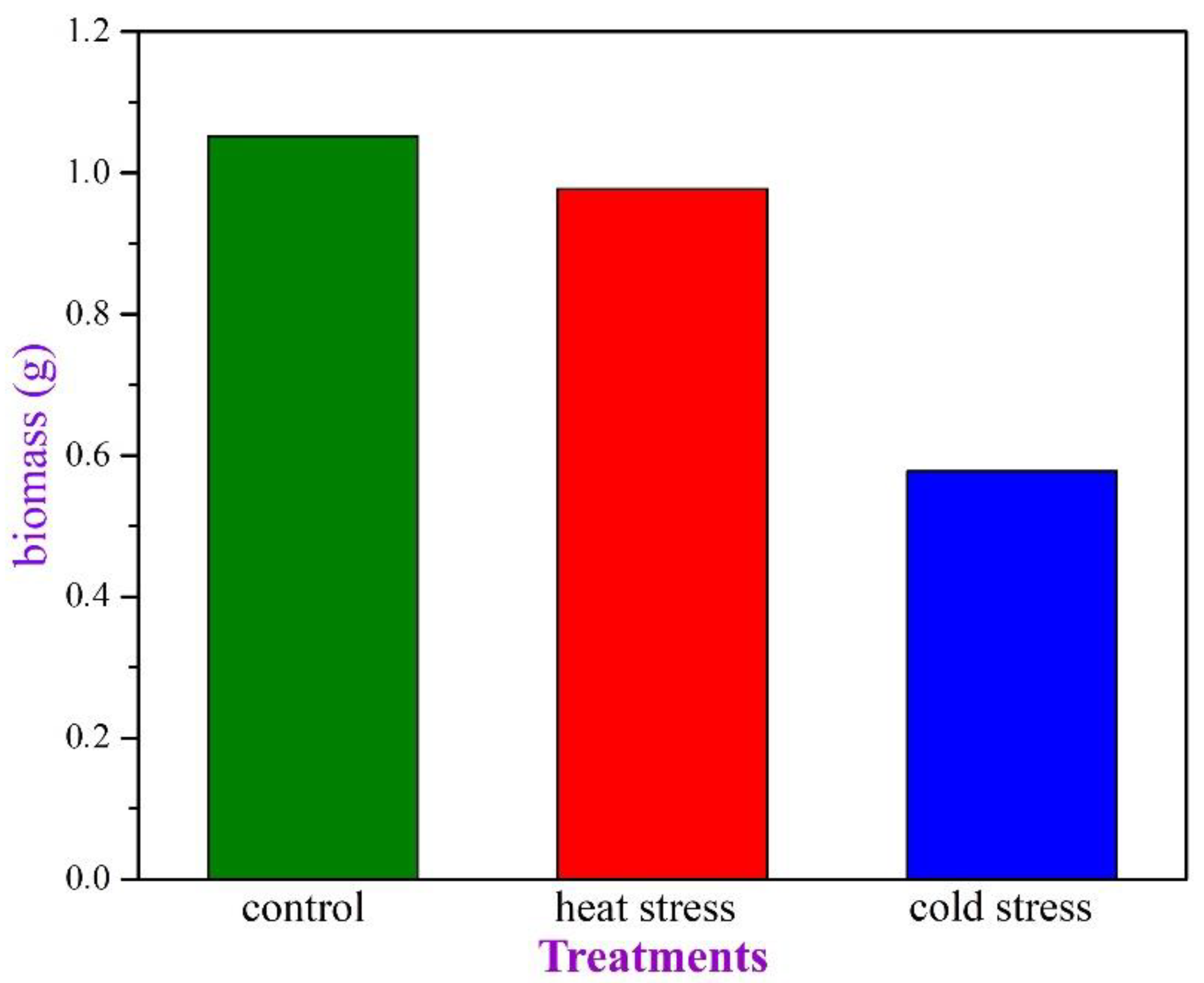
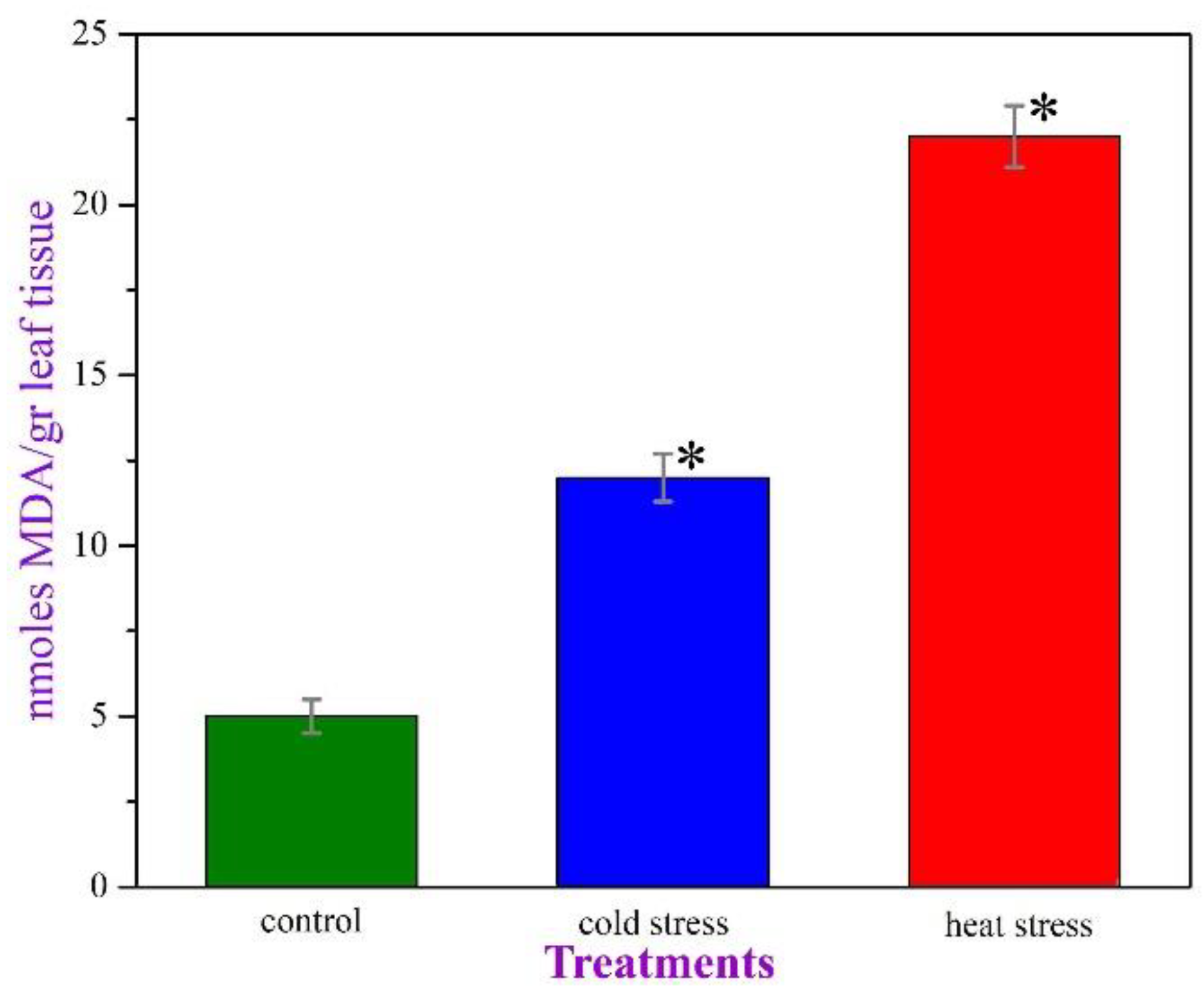
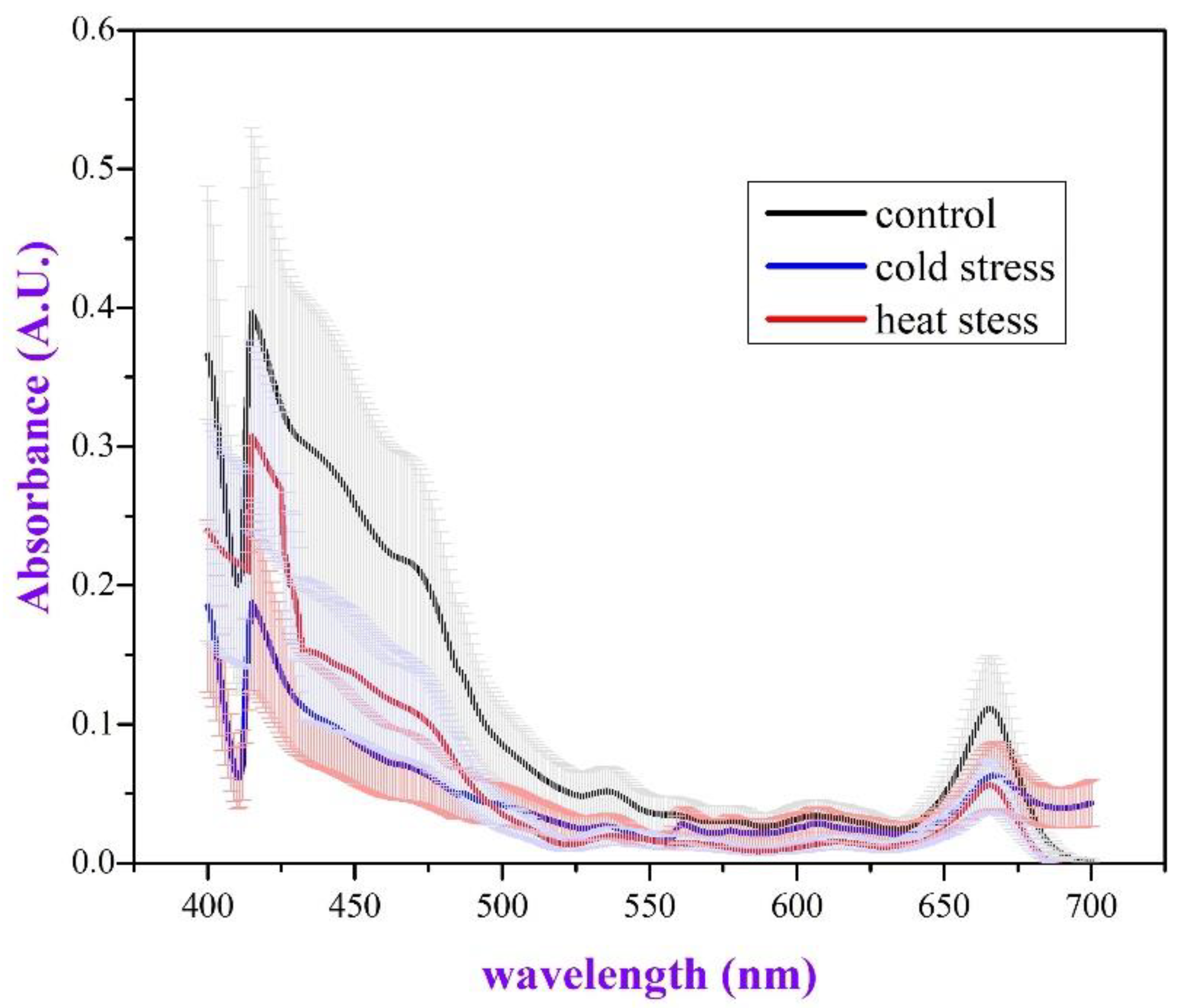
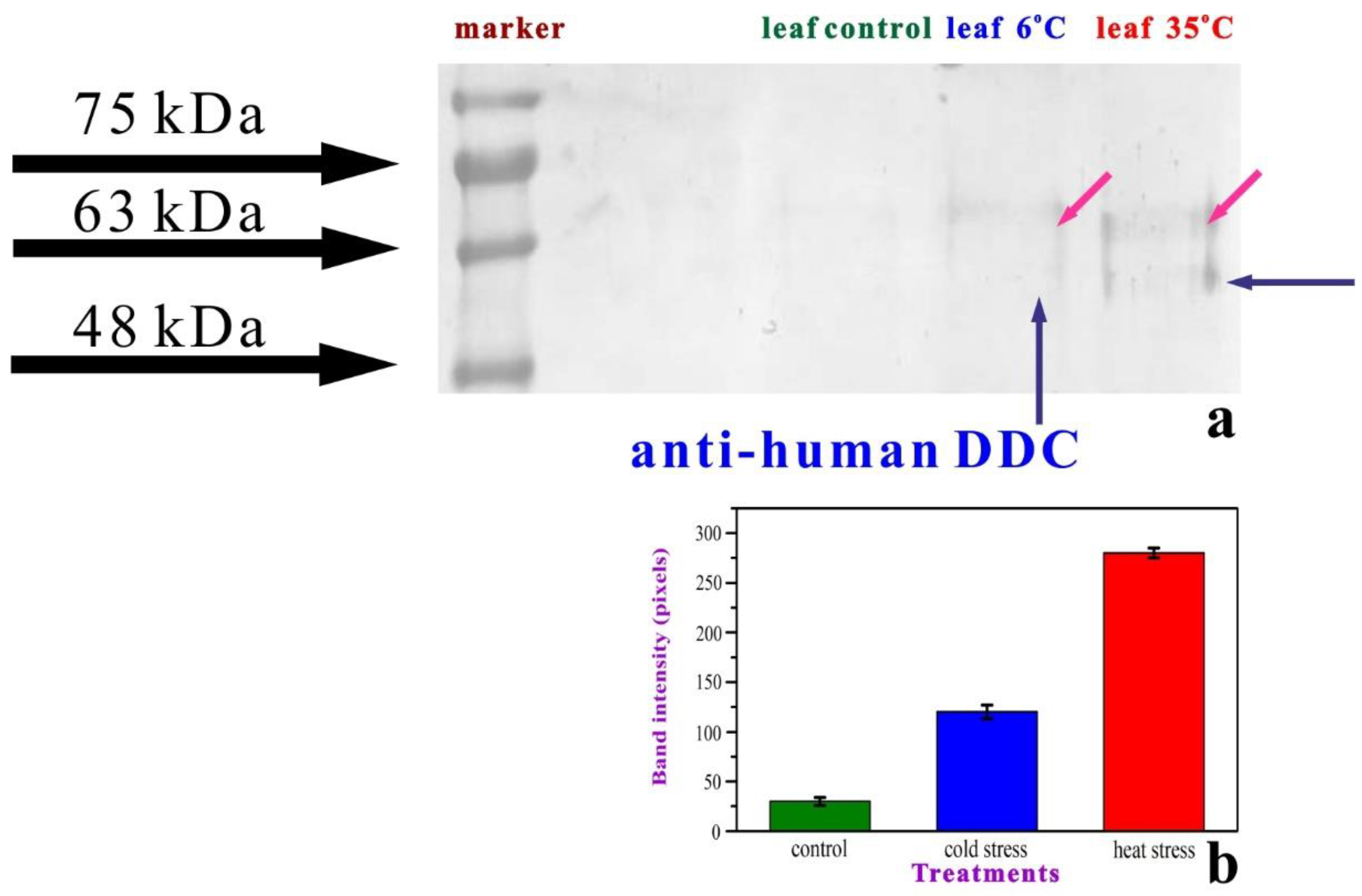
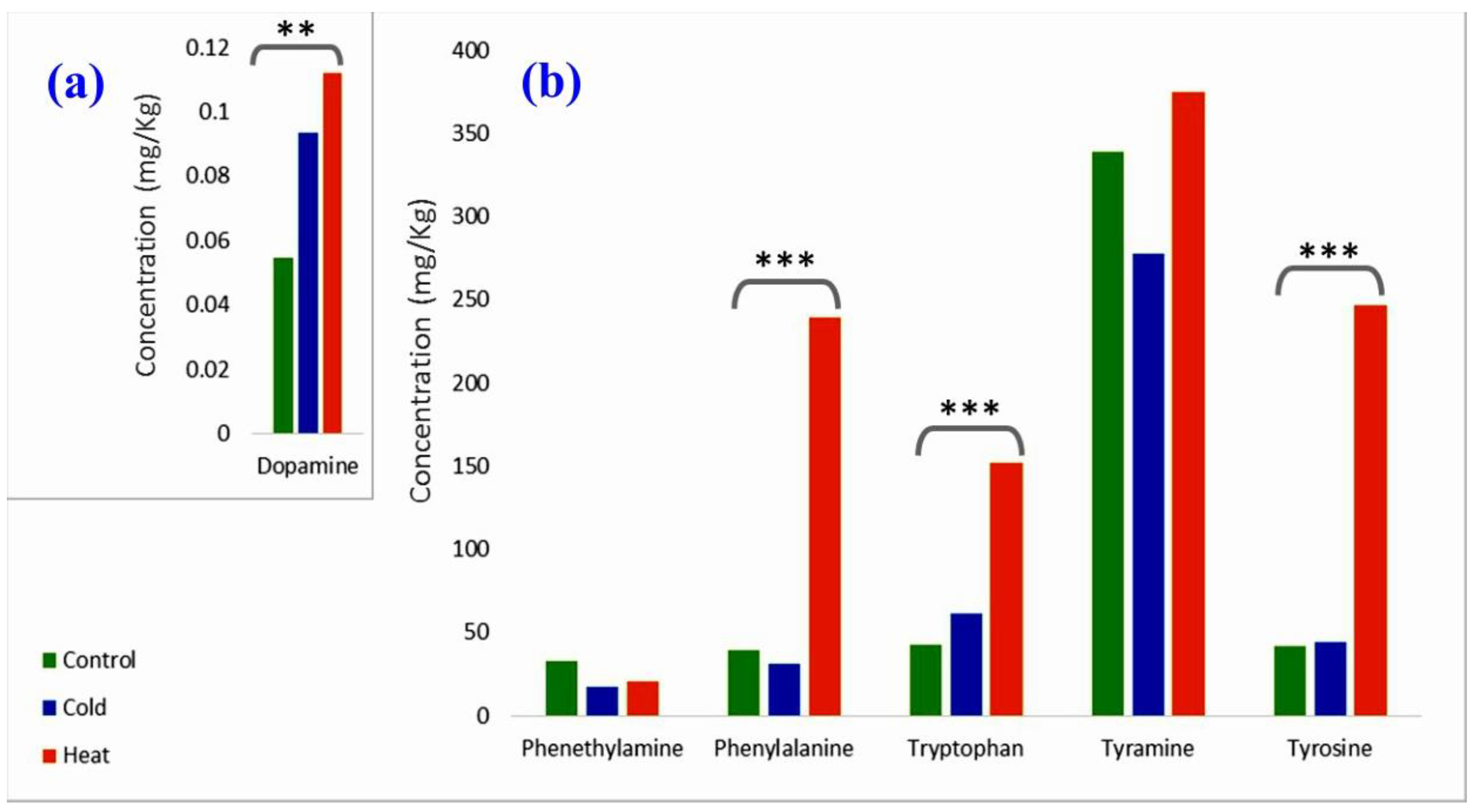
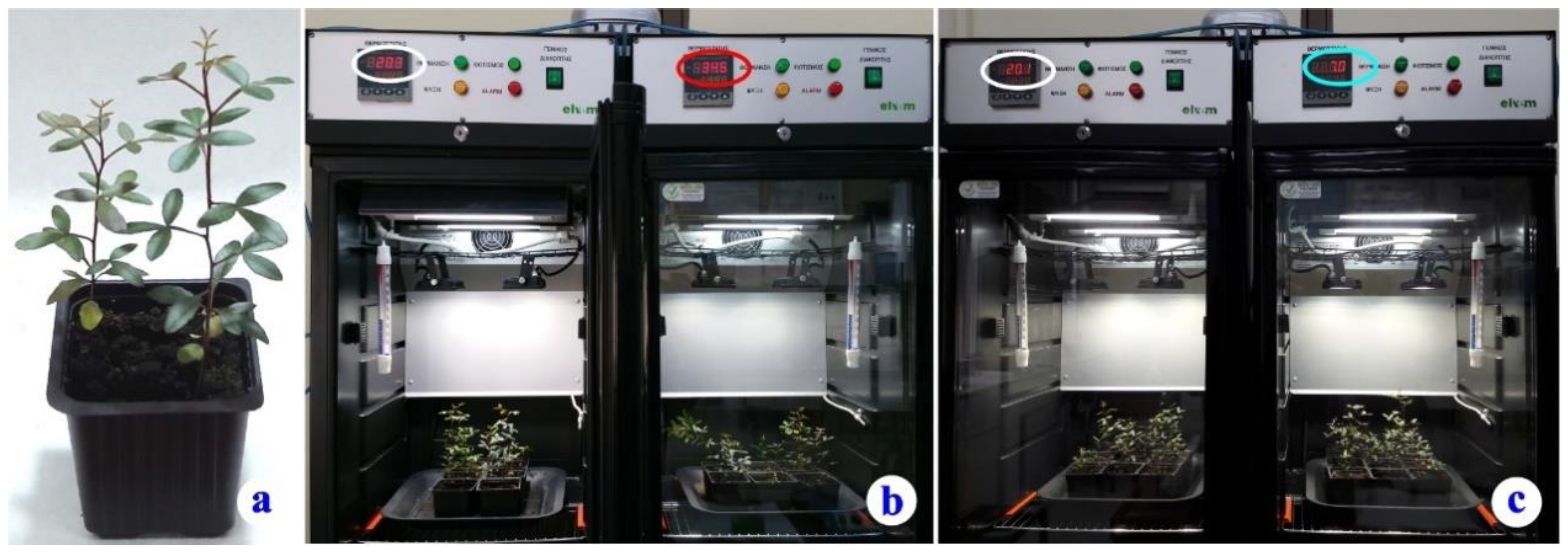
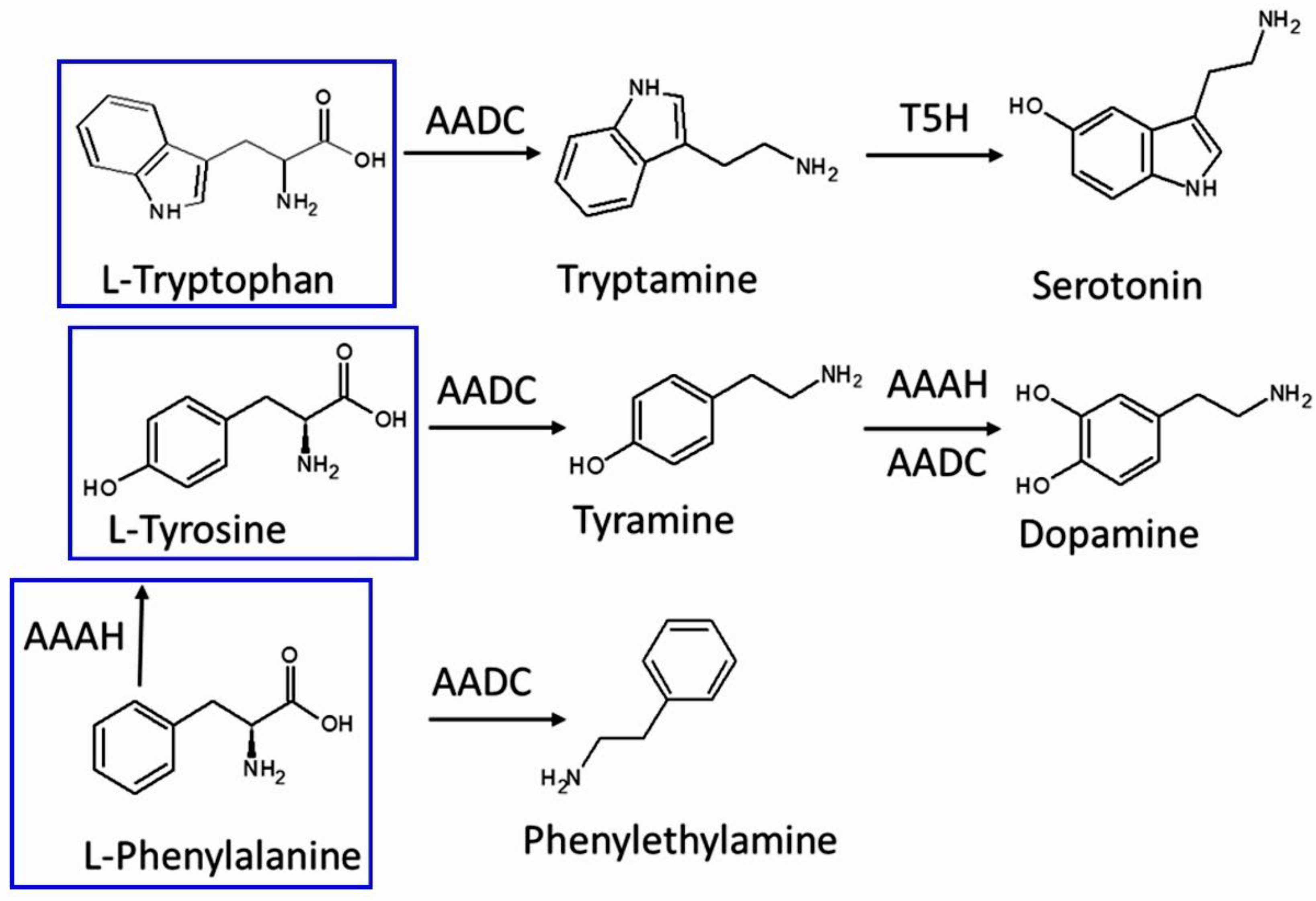
Publisher’s Note: MDPI stays neutral with regard to jurisdictional claims in published maps and institutional affiliations. |
© 2022 by the authors. Licensee MDPI, Basel, Switzerland. This article is an open access article distributed under the terms and conditions of the Creative Commons Attribution (CC BY) license (https://creativecommons.org/licenses/by/4.0/).
Share and Cite
Stefi, A.L.; Papaioannou, V.; Nikou, T.; Halabalaki, M.; Vassilacopoulou, D.; Christodoulakis, N.S. Heat and Cold-Stressed Individuals of Pistacia lentiscus (Mastic Tree) Do Modify Their Secreting Profile. Plants 2022, 11, 3290. https://doi.org/10.3390/plants11233290
Stefi AL, Papaioannou V, Nikou T, Halabalaki M, Vassilacopoulou D, Christodoulakis NS. Heat and Cold-Stressed Individuals of Pistacia lentiscus (Mastic Tree) Do Modify Their Secreting Profile. Plants. 2022; 11(23):3290. https://doi.org/10.3390/plants11233290
Chicago/Turabian StyleStefi, Aikaterina L., Varvara Papaioannou, Theodora Nikou, Maria Halabalaki, Dido Vassilacopoulou, and Nikolaos S. Christodoulakis. 2022. "Heat and Cold-Stressed Individuals of Pistacia lentiscus (Mastic Tree) Do Modify Their Secreting Profile" Plants 11, no. 23: 3290. https://doi.org/10.3390/plants11233290
APA StyleStefi, A. L., Papaioannou, V., Nikou, T., Halabalaki, M., Vassilacopoulou, D., & Christodoulakis, N. S. (2022). Heat and Cold-Stressed Individuals of Pistacia lentiscus (Mastic Tree) Do Modify Their Secreting Profile. Plants, 11(23), 3290. https://doi.org/10.3390/plants11233290





